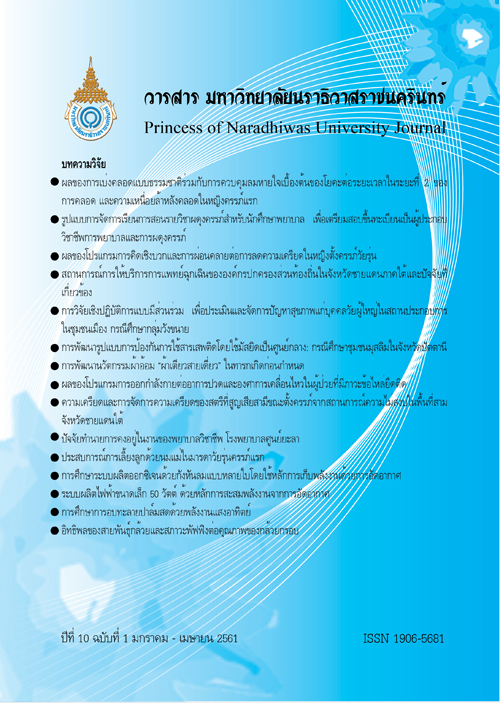The Effects of an Exercise Program on Pain and Range of Motion in Frozen Shoulder Patients
Keywords:
Exercise programs, Pain scores, Frozen shoulder, Degree of shoulder motionAbstract
This quasi-experimental research aimed to compare the average pain scores and average degree of shoulder motion in patients with frozen shoulder between control group performed standardized physical therapy and experimental group performed standardized physical therapy and exercise program. The samples were 60 frozen shoulder patients divided into 2 groups with 30 subjects in each group by simple random sampling. The instruments used in research included: general information questionnaire, physical examination and treatment record, standardized physical therapy program and exercise program. Data were analyze by descriptive statistics and t-test.
The findings demonstrated that the exercise programs with standardized physical therapy decreased the pain score significantly, increased degree of shoulder flexion, extension, abduction, adduction and internal rotation significantly compare to the standard physical therapy (p < 0.05). But the degree of shoulder external rotation between two groups are not significant differences (p> 0.05). Conclude that the exercise program reduces the pain level and increases the degree of shoulder motion. It can be used for physical therapy and should be developed for more effective treatment.
References
Kanokpran,T., Srimoragot, P., Sindhu, S. & Chuthapisith, S. (2014). The effects of a self-regulation home-based
shoulder exercise program on range of motion and functions of shoulder joints in patients post breast cancer. surgery. Journal of Nursing Division, 32(3). 74-84.
Mukpradab, S., (2014). Effects of goal attained mobility promoting program on musculoskeletal outcome in traumatic patients with immobilization. Thesis Submitted in patial Fulfillement of the Requirements for the Degree of Master of Nursing Science (Adult Nursing), p 52, Prince of Shongkha Universtiy. (In Thai).
Rungsopaskul , P., Krabounrat , J. & Ruangthai , R. (2014). A compraision of the effect rubber chain forIncrease strength and endurance upon range of motion in female patient with frozen shouder. Journal of Sport Science and Technology, 14(2), 129-144. (In Thai).
Sripoka, J., Punyakum, A., Panpeng, Y., & Seaburin, W. (2014). The effect of stretching the body of the
students enrolled in the course of the exercise for health. National education conference, 1, p 835-842.
William, E., Morgan, D.C., & Sarah Potthoff, D.C. (2012). Managing the erozen shoulder a self care guide for
those suffering from frozen shoulder. Walter Reed National Military Medical Center, p 15–21.
Retrieved November 7, 2016, from https://www.yumpu.com/s/OpsjfLw4WReecWmn.




